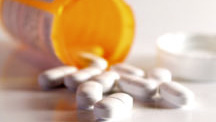Signs and Symptoms of Vicodin Abuse

Vicodin is one of the most frequently abused drugs in America. It is composed of the painkiller hydrocodone and acetaminophen in differing dosages. Hydrocodone is a strong opiate painkiller with highly addictive properties. Acetaminophen is a much milder non-steroidal pain reliever.
Vicodin may contain 5 milligrams of hydrocodone and 325 milligrams of acetaminophen or as much as 10 milligrams of hydrocodone and 660 milligrams of acetaminophen. While hydrocodone is the addictive component of this pill, acetaminophen has resulted in serious liver damage at high dosages. Taking 2 grams of acetaminophen is considered a high dosage so a person abusing Vicodin by taking a larger dosage than recommended is not only risking addiction to the opiate hydrocodone but also liver failure from the acetaminophen.
Signs of Vicodin Use or Abuse
The signs and symptoms of Vicodin abuse will be common to abuse of other opiates or synthetic opiates, referred to as opioids.
These symptoms of Vicodin Abuse include:
- Slow heartbeat
- Lightheadedness
- Confusion
- Fear
- Seizures
- Convulsions
- Nausea
- Vomiting
- Headache
- Blurred Vision
- Ringing in the Ears
- Constipation
- Constricted pupils
If a person consumes too much Vicodin, he risks slowing his heart rate down to the point of death. His skin will be clammy and he may go into a coma. Like other opiates, Vicodin is likely to make a person drowsy.
Some People Can Get Addicted by Accident
In the case of prescription drugs, many people get started on their way to addiction by accident. They may suffer some kind of pain or injury and have the drug prescribed by a doctor. As they build a tolerance to the drug, they need more and more to keep the pain away. They may exceed the amount of the drug the doctor is willing to prescribe and then start getting the drug illicitly.
Others start abusing the drug from the beginning - snorting, injecting or ingesting more than would be recommended.
Once a person is addicted, there is not much difference between the two beginnings. It eventually becomes more important to get the drug than just about anything else in life. Care of oneself, one’s business or family take a backseat to acquiring the drugs needed.
Many people who run out of the money they need to purchase opiates will turn to criminal actions to get their drugs. Pharmacy theft is one of these crimes. Around the country, Vicodin is a very common drug in pharmacy thefts. Pharmacy thefts are so frequent in some areas that some drugstore chains restrict the distribution of these drugs only a few locations.
In other cases, items of value may be missing out of a home or business or the homes of family members. It may be very hard for a family to understand that someone they have known and loved for 30 years has suddenly changed so much but that is the nature of addiction.
Recovering from Addiction to Vicodin or Other Opiates
It is definitely possible to recover from addiction to Vicodin. The person facing recovery from this addiction may dread the withdrawal process from opiates. But at a Narconon drug and alcohol rehabilitation center, it is possible to experience a tolerable withdrawal for the first time, one that does not involve the administration of other drugs.
At Narconon, withdrawal is supported with generous doses of nutrition that calm a body’s response to coming off opiates. Each person in withdrawal also receives support from the staff in the form of assists, simple processes that lift mood, increase objectivity and further calm the body.
The Narconon New Life Detoxification, one phase of the overall recovery program, takes each person through a sauna detox, assisted by moderate daily exercise and nutritional supplements that enable the body to flush out the residues of old drug abuse. Once these residues are gone, a person can regain the brightness they had before they got trapped in addiction.
With the residues of drug abuse eliminated, then the person in recovery can begin to learn how to operate in life without the drugs. It takes learning how to communicate openly and honestly again, gaining control over oneself, one’s decisions and one’s actions, and learning to make drug-free decisions. It takes longer than the month of most short-term drug rehabs to get through these changes. That’s why the Narconon program is on average eight to ten week program; it gives a person time to really get ready to be sober.
Once he is back at home, he will need to have the life skills demanded by the twists and turns of life. Once he has these skills securely in hand, he will know how to stay sober when there is an obstacle or setback in life. Learn more about the Narconon program.
See Also:
Resources:
